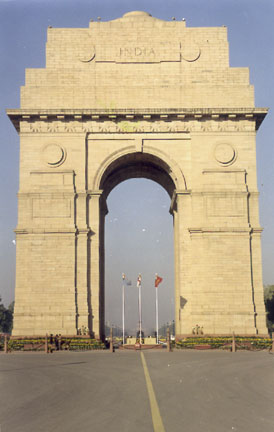![]()
 |
Introduction The All-India War Memorial 1931 Delhi Photograph © Medha Malik Kudaisya -- may be used without prior permission for any educational or scholarly purpose. |
Designed by Sir Edwin Lutyens (1869-1944) who was commissioned to build a new capital for the British after King- Emperor George V announced in 1911 at a grand ceremonial (Delhi Durbar) that the Raj would shift its capital from Calcutta to Delhi. This high structure was meant to honor the 90,000 soldiers of the Indian Army who died during World War I. Known as India Gate since the word 'India' is boldly inscribed on the entablature, the Memorial is sited at the end of the Central Vista originally called Kingsway (since renamed Rajpath) which originated at the Viceroy's Palace (now President House or Rashtrapati Bhavan) and served as the axis upon which Lutyens' design of the Capitol was based.
Chaudhuri, Nirad C. Thy Hand Great Anarch : 1921-1952. London, 1987.
Dalrymple, W. City of Djinns -- A Year in Delhi. London, 1993.
Frykenberg, F R (ed). Delhi Through the Ages. Delhi, 1986.
Gupta, Narayani. "Kingsway to Rajpath : The Democratization of Lutyens' Central Vista". Asher, Catharine B and Metcalf, T R (eds). Perceptions of South Asia's Visual Past, pp. 257-269. Delhi, 1994.
Gupta, Narayani. Delhi Between two empires, 1803-1921. Delhi, 1986
Irving, R G. Indian Summer : Lutyens, Baker and Imperial Delhi. New Haven, 1981.
Metcalf, T R. An Imperial Vision. Indian Architecture and Britain's Raj. Berkeley, 1989.